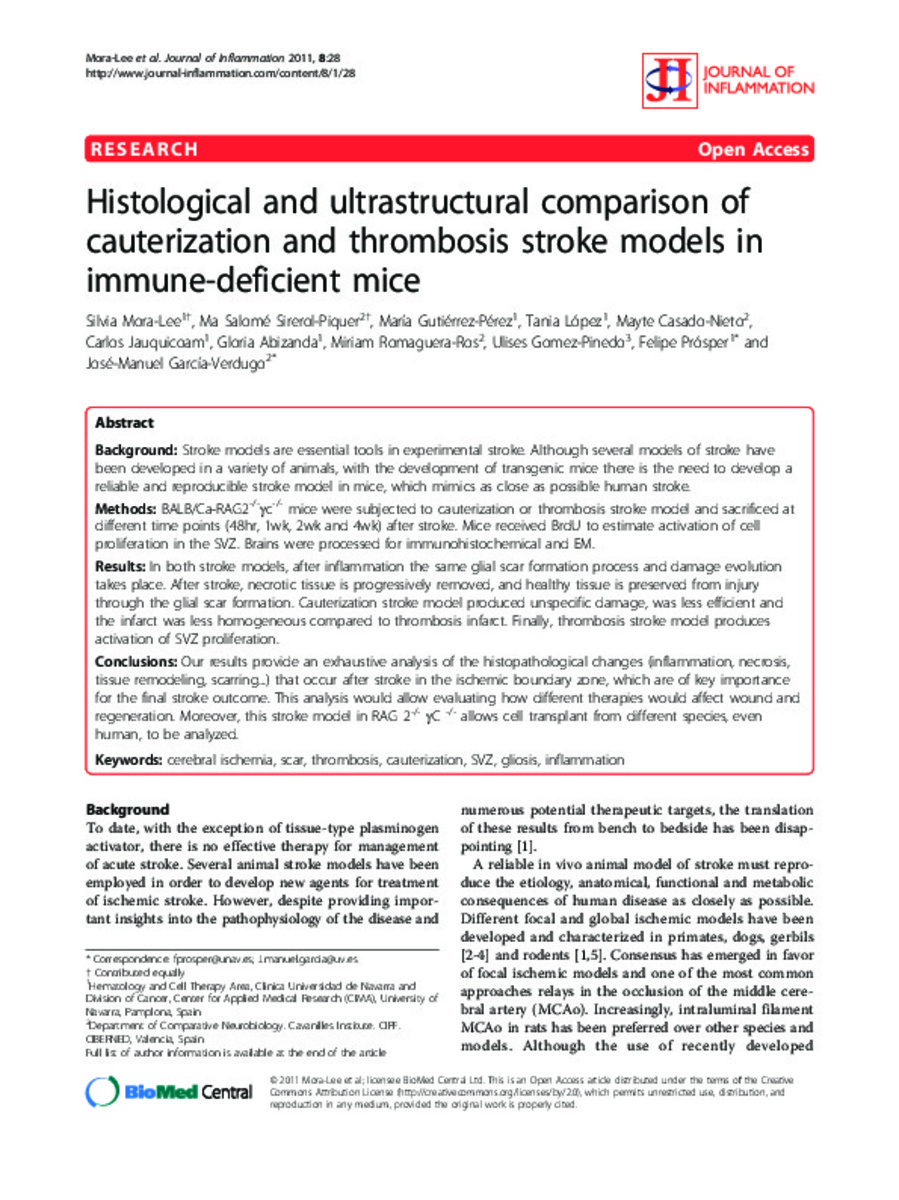Registro completo de metadatos
| Campo DC | Valor | Lengua/Idioma |
|---|---|---|
| dc.creator | Mora-Lee, S. (Silvia) | - |
| dc.creator | Sirerol-Piquer, M.S. (María Salomé) | - |
| dc.creator | Gutierrez-Perez, M. (María) | - |
| dc.creator | Lopez, T. (Tania) | - |
| dc.creator | Casado-Nieto, M. (Maite) | - |
| dc.creator | Jauquicoa, C. (Carlos) | - |
| dc.creator | Abizanda-Sarasa, G. (Gloria) | - |
| dc.creator | Romaguera-Ros, M. (Mirian) | - |
| dc.creator | Gomez-Pinedo, U. (Ulises) | - |
| dc.creator | Prosper-Cardoso, F. (Felipe) | - |
| dc.creator | Garcia-Verdugo, J.M. (José Manuel) | - |
| dc.date.accessioned | 2012-06-01T15:33:16Z | - |
| dc.date.available | 2012-06-01T15:33:16Z | - |
| dc.date.issued | 2011 | - |
| dc.identifier.citation | Mora-Lee S, Sirerol-Piquer MS, Gutierrez-Perez M, Lopez T, Casado-Nieto M, Jauquicoam C, et al. Histological and ultrastructural comparison of cauterization and thrombosis stroke models in immune-deficient mice. J Inflamm (Lond) 2011 Oct 18;8(1):28. | es_ES |
| dc.identifier.issn | 1476-9255 | - |
| dc.identifier.uri | https://hdl.handle.net/10171/22410 | - |
| dc.description.abstract | Background: Stroke models are essential tools in experimental stroke. Although several models of stroke have been developed in a variety of animals, with the development of transgenic mice there is the need to develop a reliable and reproducible stroke model in mice, which mimics as close as possible human stroke. Methods: BALB/Ca-RAG2-/-gc-/- mice were subjected to cauterization or thrombosis stroke model and sacrificed at different time points (48hr, 1wk, 2wk and 4wk) after stroke. Mice received BrdU to estimate activation of cell proliferation in the SVZ. Brains were processed for immunohistochemical and EM. Results: In both stroke models, after inflammation the same glial scar formation process and damage evolution takes place. After stroke, necrotic tissue is progressively removed, and healthy tissue is preserved from injury through the glial scar formation. Cauterization stroke model produced unspecific damage, was less efficient and the infarct was less homogeneous compared to thrombosis infarct. Finally, thrombosis stroke model produces activation of SVZ proliferation. Conclusions: Our results provide an exhaustive analysis of the histopathological changes (inflammation, necrosis, tissue remodeling, scarring...) that occur after stroke in the ischemic boundary zone, which are of key importance for the final stroke outcome. This analysis would allow evaluating how different therapies would affect wound and regeneration. Moreover, this stroke model in RAG 2-/- gC -/- allows cell transplant from different species, even human, to be analyzed. | es_ES |
| dc.language.iso | eng | es_ES |
| dc.publisher | BioMed Central | es_ES |
| dc.rights | info:eu-repo/semantics/openAccess | es_ES |
| dc.subject | Cerebral ischemia | es_ES |
| dc.subject | Inflammation | es_ES |
| dc.subject | Thrombosis | es_ES |
| dc.title | Histological and ultrastructural comparison of cauterization and thrombosis stroke models in immune-deficient mice | es_ES |
| dc.type | info:eu-repo/semantics/article | es_ES |
| dc.type.driver | info:eu-repo/semantics/article | es_ES |
| dc.identifier.doi | http://dx.doi.org/10.1186/1476-9255-8-28 | es_ES |
Ficheros en este ítem:
Estadísticas e impacto
Los ítems de Dadun están protegidos por copyright, con todos los derechos reservados, a menos que se indique lo contrario.






